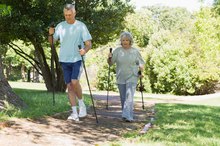What does fact checked mean?
At Healthfully, we strive to deliver objective content that is accurate and up-to-date. Our team periodically reviews articles in order to ensure content quality. The sources cited below consist of evidence from peer-reviewed journals, prominent medical organizations, academic associations, and government data.
The information contained on this site is for informational purposes only, and should not be used as a substitute for the advice of a professional health care provider. Please check with the appropriate physician regarding health questions and concerns. Although we strive to deliver accurate and up-to-date information, no guarantee to that effect is made.
Exercise Facts for Kids
Children who are overweight are at risk for developing health problems. Children who are sedentary are much more likely to become obese, which can lead to diabetes, early puberty and other weight-related maladies. Regular exercise can help children stay healthy or get healthier.
Benefits
Children benefit from exercise in several ways. They will experience a heightened ability to deal with the physical and emotional stresses of daily life. Also, exercise burns calories consumed, so children will benefit from a reduction in body fat and improved body image. Risks for high blood pressure, type 2 diabetes, and blood cholesterol levels are reduced with exercise. Physical activity also helps children strengthen bones and muscles.
- Children benefit from exercise in several ways.
- Also, exercise burns calories consumed, so children will benefit from a reduction in body fat and improved body image.
Types of Exercises
Why is Regular Exercise Important For Children?
Learn More
Children can engage in many activities that build cardiovascular endurance, strength and flexibility. These activities can include walking, jogging, organized sports, bicycling or just a simple game of tag, as well as any other repetitive movement that increases heart rate over an extended period of time.
Frequency and Duration
Kids should exercise as frequently as possible. The American Heart Association suggests children age 2 and over should exercise at least 30 to 60 minutes every day. These periods of exercise do not have to occur in one 30-minute session. Kids can run and play in several sessions that add up to 30 minutes or more.
- Kids should exercise as frequently as possible.
- Kids can run and play in several sessions that add up to 30 minutes or more.
Intensity
Exercise and Unclogging Heart Arteries
Learn More
Exercise that produces physical benefits should be of moderate or vigorous intensity. According to the Centers for Disease Control, moderate exercise is activity that is equivalent to walking at a brisk pace, gymnastics, ballet or softball 2. Vigorous activity is the equivalent of most competitive sports, jumping rope, jogging or running.
Encouraging Kids to Exercise
Adults should do their best to make physical activity fun for children. This encourages the continuation of an active lifestyle through adulthood. Participating with your child or setting an example through your own exercise is a great way to encourage kids to lead an active life. Limit the amount of time children are allowed to spend in sedentary activities such as television or video games.
- Adults should do their best to make physical activity fun for children.
- Participating with your child or setting an example through your own exercise is a great way to encourage kids to lead an active life.
Related Articles
References
- National Institutes of Health
- Centers For Disease Control
- Roth, Walton, et al. Fit & Well: Concepts and Labs in Physical Fitness and Wellness 5th Ed. Boston: McGraw-Hill College, 2002.
Writer Bio
Cynthia Hunter is a health and fitness writer in San Diego, CA who began writing in 2009. She is a National Academy of Sports Medicine-Certified Personal Trainer, Performance Enhancement Specialist and a Master Fitness Specialist certified through the Cooper Institute. Hunter's articles have been featured in many online publications including eHow and LIVESTRONG.COM. Hunter is currently working toward a degree in medicine.









